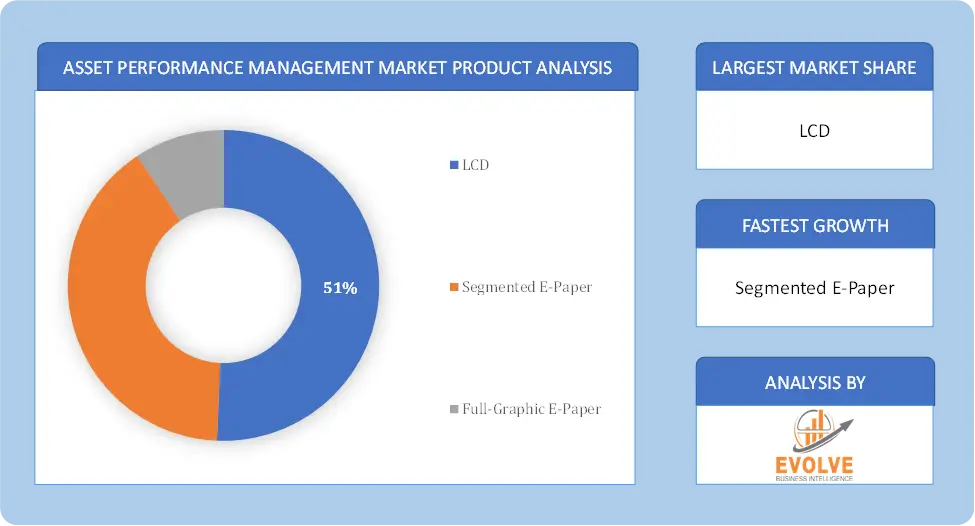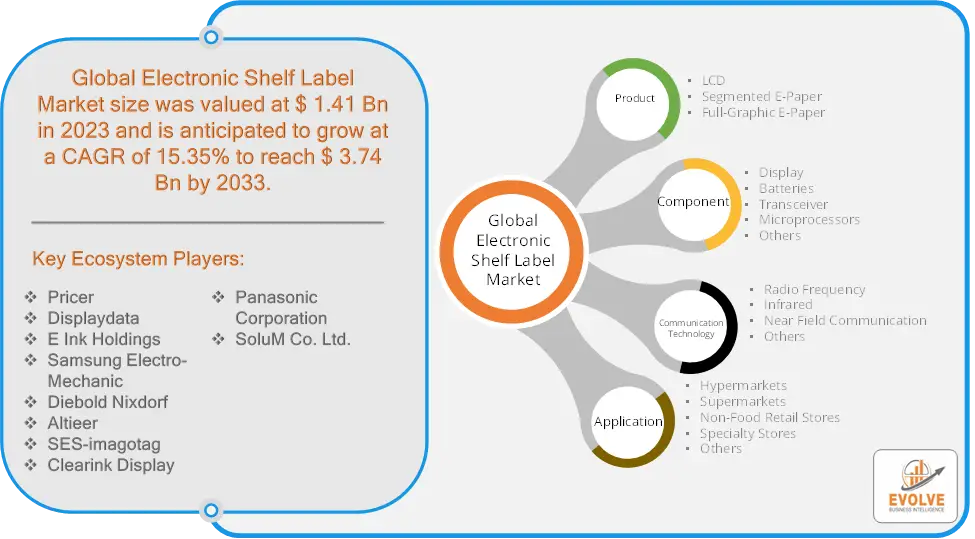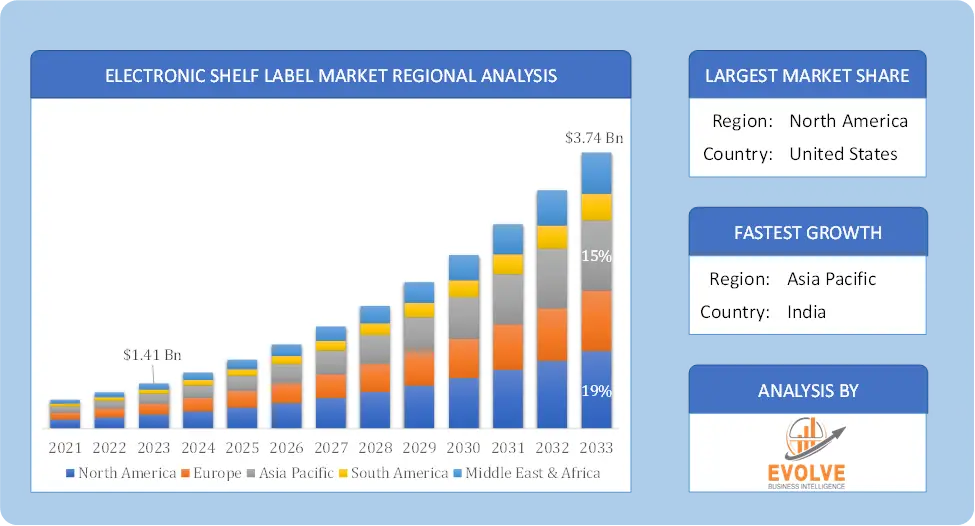Electronic Shelf Label Market Analysis and Global Forecast 2023-2033
$ 1,390.00 – $ 5,520.00Price range: $ 1,390.00 through $ 5,520.00
Electronic Shelf Label Market Research Report: Information By Product Type (LCD, Segmented E-Paper, Full-Graphic E-Paper), By Component (Displays, Batteries, Transceiver, Microprocessors, Others), By Communication Technology (Radio Frequency, Infrared, Near Field Communication, Others,) By End User (Hypermarkets, Supermarkets, Non-Food Retail Stores, Specialty Stores, Others), and by Region — Forecast till 2033
Page: 99
Electronic Shelf Label Market Overview
The Electronic Shelf Label Market Size is expected to reach USD 3.74 Billion by 2033. The Electronic Shelf Label Market industry size accounted for USD 1.41 Billion in 2023 and is expected to expand at a compound annual growth rate (CAGR) of 15.35% from 2023 to 2033. Electronic Shelf Labels (ESLs) are digital display systems that replace traditional paper labels on store shelves. These labels are capable of displaying and updating product pricing, information, and promotions in real-time. They are typically battery-powered and wirelessly connected to a central system, allowing for efficient and accurate management of product information across a store.
The ESL market has been experiencing significant growth due to the increasing adoption of digital technologies in the retail industry. Factors such as rising labour costs, the need for improved efficiency, and the desire for enhanced customer experiences are driving the demand for ESL solutions.
Global Electronic Shelf Label Market Synopsis
The COVID-19 pandemic had a significant impact on the Electronic Shelf Label (ESL) Market. The pandemic heightened the need for contactless shopping experiences to reduce the risk of virus transmission. ESLs, which can be updated remotely and automatically, gained traction as a tool to minimize human interaction in stores. The global supply chain was disrupted during the pandemic, leading to shortages of essential components for ESLs, such as semiconductors and displays. This caused delays in manufacturing and deployment of ESL systems. ESLs allowed retailers to quickly update pricing and product information, which was crucial during the pandemic when supply chains were volatile, and stock levels frequently changed. As the retail sector began to recover, the demand for ESLs continued to grow, driven by the lessons learned during the pandemic about the importance of digital and automated solutions in ensuring business continuity. The pandemic underscored the importance of safety and efficiency in retail, leading to sustained interest in ESLs as part of a broader strategy to future-proof retail operations.
Electronic Shelf Label Market Dynamics
The major factors that have impacted the growth of Electronic Shelf Label Market are as follows:
Drivers:
Ø Operational Efficiency and Cost Reduction
ESLs reduce the need for manual price updates, leading to significant savings in labor costs. Retailers can reallocate staff to other tasks, improving overall store efficiency. With ESLs, prices can be changed instantly across multiple locations, reducing the time and errors associated with manual updates. This capability is particularly beneficial during sales, promotions, and price adjustments. Retailers can respond quickly to competitors’ pricing changes, optimizing sales and margins in real-time. This flexibility is especially important in highly competitive markets. ESLs enable retailers to offer targeted discounts and promotions based on customer profiles or purchasing history, increasing customer loyalty and sales.
Restraint:
- Perception of High Initial Investment Costs
The cost of implementing ESL systems, including the hardware (labels), software, and installation, can be substantial, especially for large retail chains with numerous outlets. This high initial investment can be a barrier, particularly for small and medium-sized retailers with limited budgets. Although ESLs can lead to long-term savings in labor and operational efficiency, the time required to achieve a positive ROI can be a deterrent for retailers who are hesitant to make significant upfront expenditures.
Opportunity:
⮚ Integration with Advanced Technologies
ESLs can be integrated with Internet of Things (IoT) networks to create smart retail environments. For example, ESLs can be connected to inventory management systems, enabling automated price adjustments based on stock levels, demand forecasts, or competitor pricing. The use of AI and machine learning can enhance ESL systems by enabling predictive pricing, personalized promotions, and dynamic content displays, further improving customer engagement and sales.
Electronic Shelf Label Market Segment Overview
By Product Type
 Based on Product Type, the market is segmented based on LCD, Segmented E-Paper and Full-Graphic E-Paper. The LCD segment dominant the market. The electronic shelf label (ESL) market has experienced substantial growth with the introduction of LCD-type ESLs, leveraging Liquid Crystal Display (LCD) technology to provide retailers with dynamic and efficient pricing and information management solutions. These labels enable real-time updates across multiple shelves, enhancing operational efficiency and accuracy compared to static paper labels.
Based on Product Type, the market is segmented based on LCD, Segmented E-Paper and Full-Graphic E-Paper. The LCD segment dominant the market. The electronic shelf label (ESL) market has experienced substantial growth with the introduction of LCD-type ESLs, leveraging Liquid Crystal Display (LCD) technology to provide retailers with dynamic and efficient pricing and information management solutions. These labels enable real-time updates across multiple shelves, enhancing operational efficiency and accuracy compared to static paper labels.
By Component
Based on Component, the market segment has been divided into Displays, Batteries, Transceiver, Microprocessors and Others. The display segment dominant the market. The electronic shelf label (ESL) market has experienced significant growth driven by the demand for real-time price management and automation, enhancing operational efficiency and customer engagement in retail environments. Leveraging Internet of Things (IoT) technology, ESLs offer dynamic pricing strategies and integrate seamlessly with smart retail solutions, providing valuable insights for informed decision-making. E-ink displays, with their low power consumption and paper-like readability, have revolutionized ESLs by ensuring clarity, adaptability, and sustainability without continuous power supply, meeting the need for efficient inventory management and dynamic pricing updates.
By Communication Technology
Based on Communication Technology, the market segment has been divided into Radio Frequency, Infrared, Near Field Communication and Others. The radio frequency segment dominant the market. Radiofrequency technology is witnessing prominent growth, owing to its ability to provide bidirectional communication. In ESL, it transmits pricing and product information and receives updates. Moreover, the growing application of radio frequency in other technologies, such as ZigBee, Z-Wave, and BLE, contributes to the increased demand for radio frequency in electronic labels.
By End Use
Based on End Use, the market segment has been divided into Hypermarkets, Supermarkets, Non-Food Retail Stores, Specialty Stores and Others. The hypermarket segment dominant the market. Digital technologies are significantly increasing their adoption in hypermarkets as they display information to help consumers better in-store navigation. This, in turn, is a significant factor expected to drive the growth of the global market. In addition, hypermarkets are facilitating automation solutions to provide consumers with an Omni-commerce experience, which is further expected to help consumers at a relatively high rate.
Global Electronic Shelf Label Market Regional Analysis
Based on region, the global Electronic Shelf Label Market has been divided into North America, Europe, Asia-Pacific, the Middle East & Africa, and Latin America. North America is projected to dominate the use of the Electronic Shelf Label Market followed by the Asia-Pacific and Europe regions.
 Electronic Shelf Label North America Market
Electronic Shelf Label North America Market
North America holds a dominant position in the Electronic Shelf Label Market. North America, particularly the United States and Canada, is a mature market for ESLs, with significant adoption among large retail chains like supermarkets, hypermarkets, and specialty stores and the region benefits from advanced retail infrastructure, high labor costs, and a strong focus on automation and efficiency. Retailers in North America are early adopters of new technologies, including ESLs, driven by the need to stay competitive and improve customer experience.
Electronic Shelf Label Asia-Pacific Market
The Asia-Pacific region has indeed emerged as the fastest-growing market for the Electronic Shelf Label Market industry. The Asia-Pacific region is experiencing rapid growth in ESL adoption, with key markets including China, Japan, South Korea, and Australia. This region is characterized by a mix of mature and emerging retail markets. The rapid modernization of the retail sector, increasing urbanization, and a growing middle class are driving ESL adoption. Countries like Japan and South Korea are leading in terms of technological innovation, making them early adopters of advanced retail technologies like ESLs.
Competitive Landscape
The global Electronic Shelf Label Market is highly competitive, with numerous players offering a wide range of software solutions. The competitive landscape is characterized by the presence of established companies, as well as emerging startups and niche players. To increase their market position and attract a wide consumer base, the businesses are employing various strategies, such as product launches, and strategic alliances.
Prominent Players:
- Pricer
- Displaydata
- E Ink Holdings
- Samsung Electro- Mechanic
- Diebold Nixdorf
- Altieer
- SES-imagotag
- Clearink Display
- Panasonic Corporation
- SoluM Co. Ltd.
Key Development
In April 2023, Hanshow unveiled the Nebular Pro series of four-color ESLs, ushering in a new era of vibrant and innovative digital retail experiences at the “Revitalization and Excellence” product launch in China.
In November 2023, RAINUS partnered with Toshiba Global Commerce Solutions, offering ESL technology for seamless dynamic pricing, enhancing store solutions, and addressing labor challenges in retail.
Scope of the Report
Global Electronic Shelf Label Market, by Product
- LCD
- Segmented E-Paper
- Full-Graphic E-Paper
Global Electronic Shelf Label Market, by Component
- Display
- Batteries
- Transceiver
- Microprocessors
- Others
Global Electronic Shelf Label Market, by Communication Technology
- Radio Frequency
- Infrared
- Near Field Communication
- Others
Global Electronic Shelf Label Market, by Application
- Hypermarkets
- Supermarkets
- Non-Food Retail Stores
- Specialty Stores
- Others
Global Electronic Shelf Label Market, by Region
- North America
- US
- Canada
- Mexico
- Europe
- UK
- Germany
- France
- Italy
- Spain
- Benelux
- Nordic
- Rest of Europe
- Asia Pacific
- China
- Japan
- South Korea
- Indonesia
- Austalia
- Malaysia
- India
- Rest of Asia Pacific
- South America
- Brazil
- Argentina
- Rest of South America
- Middle East & Africa
- Saudi Arabia
- UAE
- Egypt
- South Africa
- Rest of Middle East & Africa
| Parameters | Indicators |
|---|---|
| Market Size | 2033: $3.74 Billion |
| CAGR | 15.35% CAGR (2023-2033) |
| Base year | 2022 |
| Forecast Period | 2023-2033 |
| Historical Data | 2021 |
| Report Coverage | Revenue Forecast, Competitive Landscape, Growth Factors, and Trends |
| Key Segmentations | Product Type, Component, Communication Technology, End Use |
| Geographies Covered | North America, Europe, Asia-Pacific, Latin America, Middle East, Africa |
| Key Vendors | Pricer, Displaydata, E Ink Holdings, Samsung Electro- Mechanic, Diebold Nixdorf, Altieer, SES-imagotag, Clearink Display, Panasonic Corporation and SoluM Co. Ltd |
| Key Market Opportunities | • Integration with Advanced Technologies |
| Key Market Drivers | • Operational Efficiency and Cost Reduction |
REPORT CONTENT BRIEF:
- High-level analysis of the current and future Electronic Shelf Label Market trends and opportunities
- Detailed analysis of current market drivers, restraining factors, and opportunities in the future
- Electronic Shelf Label Market historical market size for the year 2021, and forecast from 2023 to 2033
- Electronic Shelf Label Market share analysis at each product level
- Competitor analysis with detailed insight into its product segment, Government & Defense strength, and strategies adopted.
- Identifies key strategies adopted including product launches and developments, mergers and acquisitions, joint ventures, collaborations, and partnerships as well as funding taken and investment done, among others.
- To identify and understand the various factors involved in the global Electronic Shelf Label Market affected by the pandemic
- To provide a detailed insight into the major companies operating in the market. The profiling will include the Government & Defense health of the company’s past 2-3 years with segmental and regional revenue breakup, product offering, recent developments, SWOT analysis, and key strategies.
Press Release

Global Pharmaceutical Manufacturing Market to Reach $1.38 Trillion by 2035 with 7.35% CAGR, New Research Shows

The Global Mammography Market Is Estimated To Record a CAGR of Around 10.29% During The Forecast Period

Glue Stick Market to Reach USD 2.35 Billion by 2034

Podiatry Service Market to Reach USD 11.88 Billion by 2034

Microfluidics Technology Market to Reach USD 32.58 Billion by 2034

Ferric Chloride Market to Reach USD 10.65 Billion by 2034

Family Practice EMR Software Market to Reach USD 21.52 Billion by 2034

Electric Hairbrush Market to Reach USD 15.95 Billion by 2034

Daily Bamboo Products Market to Reach USD 143.52 Billion by 2034

Cross-border E-commerce Logistics Market to Reach USD 112.65 Billion by 2034
Frequently Asked Questions (FAQ)
What is the study period of this market?
The study period of the global Electronic Shelf Label Marke tis 2021- 2033
What is the growth rate of the global Electronic Shelf Label Market?
The global Electronic Shelf Label Market is growing at a CAGR of 15.35% over the next 10 years
Which region has the highest growth rate in the market of Frozen Food?
Asia Pacific is expected to register the highest CAGR during 2023-2033
Which region has the largest share of the global Electronic Shelf Label Market?
North America holds the largest share in 2022
Who are the key players in the global Electronic Shelf Label Market?
Pricer, Displaydata, E Ink Holdings, Samsung Electro- Mechanic, Diebold Nixdorf, Altieer, SES-imagotag, Clearink Display, Panasonic Corporation and SoluM Co. Ltd are the major companies operating in the market
Do you offer Post Sale Support?
Yes, we offer 16 hours of analyst support to solve the queries
Do you sell particular sections of a report?
Yes, we provide regional as well as country-level reports. Other than this we also provide a sectional report. Please get in contact with our sales representatives
Table of Content
Chapter 1. Executive Summary Chapter 2. Scope of The Study 2.1. Market Definition 2.2. Scope of The Study 2.2.1. Objectives of Report Chapter 3. Evolve BI Methodology Chapter 4. Market Insights and Trends 4.1. Supply/ Value Chain Analysis 4.2. Porter’s Five Forces Analysis 4.2.1. Threat of New Entrants 4.2.2. Bargaining Power of Buyers 4.2.3. Bargaining Power of Suppliers 4.2.4. Threat of Substitutes 4.2.5. Industry Rivalry 4.3. Impact of COVID-19 on Electronic Shelf Label Market 4.3.1. Impact on Market Size 4.3.2. End User Trend, Preferences and Budget Impact 4.3.3. Regulatory Framework/Government Policies 4.3.4. Key Players Strategy to Tackle Negative Impact 4.3.5. Opportunity Window Chapter 5. Market Dynamics 5.1. Introduction 5.2. DRO Analysis 5.2.1. Drivers 5.2.2. Restraints 5.2.3. Opportunities Chapter 6. Global Electronic Shelf Label Market, By Product Type 6.1. Introduction 6.2. LCD 6.3. Segmented E-Paper 6.4. Full-Graphic E-Paper Chapter 7. Global Electronic Shelf Label Market, By Component 7.1. Introduction 7.2. Displays 7.3. Batteries 7.4. Transceiver 7.5. Microprocessors 7.6. Others Chapter 8. Global Electronic Shelf Label Market, By Communication Technology 8.1. Introduction 8.2. Radio Frequency 8.3. Infrared 8.4. Near Field Communication 8.5. Others Chapter 9. Global Electronic Shelf Label Market, By End Use 9.1. Introduction 9.2. Hypermarkets 9.3. Supermarkets 9.4. Non-Food Retail Stores 9.5. Specialty Stores 9.6. Others Chapter 10. Global Electronic Shelf Label Market, By Region 10.1. Introduction 10.2. North America 10.2.1. Introduction 10.2.2. Driving Factors, Opportunity Analyzed and Key Trends 10.2.3. Market Size and Forecast, By Country, 2020 - 2028 10.2.4. Market Size and Forecast, By Product Type, 2020 - 2028 10.2.5. Market Size and Forecast, By Component, 2020 - 2028 10.2.6. Market Size and Forecast, By Communication Technology, 2020 – 2028 10.2.7. Market Size and Forecast, By End User, 2020 – 2028 10.2.8. US 10.2.8.1. Introduction 10.2.8.2. Driving Factors, Opportunity Analyzed and Key Trends 10.2.8.3. Market Size and Forecast, By Product Type, 2020 - 2028 10.2.8.4. Market Size and Forecast, By Component, 2020 - 2028 10.2.8.5. Market Size and Forecast, By Communication Technology, 2020 – 2028 10.2.8.6. Market Size and Forecast, By End User, 2020 - 2028 10.2.9. Canada 10.2.9.1. Introduction 10.2.9.2. Driving Factors, Opportunity Analyzed and Key Trends 10.2.9.3. Market Size and Forecast, By Product Type, 2020 - 2028 10.2.9.4. Market Size and Forecast, By Component, 2020 - 2028 10.2.9.5. Market Size and Forecast, By Communication Technology, 2020 – 2028 10.2.9.6. Market Size and Forecast, By End User, 2020 - 2028 10.3. Europe 10.3.1. Introduction 10.3.2. Driving Factors, Opportunity Analyzed and Key Trends 10.3.3. Market Size and Forecast, By Country, 2020 - 2028 10.3.4. Market Size and Forecast, By Product Type, 2020 - 2028 10.3.5. Market Size and Forecast, By Component, 2020 - 2028 10.3.6. Market Size and Forecast, By Communication Technology, 2020 – 2028 10.3.7. Market Size and Forecast, By End User, 2020 – 2028 10.3.8. Germany 10.3.8.1. Introduction 10.3.8.2. Driving Factors, Opportunity Analyzed and Key Trends 10.3.8.3. Market Size and Forecast, By Product Type, 2020 - 2028 10.3.8.4. Market Size and Forecast, By Component, 2020 - 2028 10.3.8.5. Market Size and Forecast, By Communication Technology, 2020 – 2028 10.3.8.6. Market Size and Forecast, By End User, 2020 - 2028 10.3.9. France 10.3.9.1. Introduction 10.3.9.2. Driving Factors, Opportunity Analyzed and Key Trends 10.3.9.3. Market Size and Forecast, By Product Type, 2020 - 2028 10.3.9.4. Market Size and Forecast, By Component, 2020 - 2028 10.3.9.5. Market Size and Forecast, By Communication Technology, 2020 – 2028 10.3.9.6. Market Size and Forecast, By End User, 2020 - 2028 10.3.10. UK 10.3.10.1. Introduction 10.3.10.2. Driving Factors, Opportunity Analyzed and Key Trends 10.3.10.3. Market Size and Forecast, By Product Type, 2020 - 2028 10.3.10.4. Market Size and Forecast, By Component, 2020 - 2028 10.3.10.5. Market Size and Forecast, By Communication Technology, 2020 – 2028 10.3.10.6. Market Size and Forecast, By End User, 2020 - 2028 10.3.11. Italy 10.3.11.1. Introduction 10.3.11.2. Driving Factors, Opportunity Analyzed and Key Trends 10.3.11.3. Market Size and Forecast, By Product Type, 2020 - 2028 10.3.11.4. Market Size and Forecast, By Component, 2020 - 2028 10.3.11.5. Market Size and Forecast, By Communication Technology, 2020 – 2028 10.3.11.6. Market Size and Forecast, By End User, 2020 - 2028 10.3.12. Rest of Europe 10.3.12.1. Introduction 10.3.12.2. Driving Factors, Opportunity Analyzed and Key Trends 10.3.12.3. Market Size and Forecast, By Product Type, 2020 - 2028 10.3.12.4. Market Size and Forecast, By Component, 2020 - 2028 10.3.12.5. Market Size and Forecast, By Communication Technology, 2020 – 2028 10.3.12.6. Market Size and Forecast, By End User, 2020 - 2028 10.4. Asia-Pacific 10.4.1. Introduction 10.4.2. Driving Factors, Opportunity Analyzed and Key Trends 10.4.3. Market Size and Forecast, By Country, 2020 - 2028 10.4.4. Market Size and Forecast, By Product Type, 2020 - 2028 10.4.5. Market Size and Forecast, By Component, 2020 - 2028 10.4.6. Market Size and Forecast, By Communication Technology, 2020 – 2028 10.4.7. Market Size and Forecast, By End User, 2020 - 2028 10.4.8. China 10.4.8.1. Introduction 10.4.8.2. Driving Factors, Opportunity Analyzed and Key Trends 10.4.8.3. Market Size and Forecast, By Product Type, 2020 - 2028 10.4.8.4. Market Size and Forecast, By Component, 2020 - 2028 10.4.8.5. Market Size and Forecast, By Communication Technology, 2020 – 2028 10.4.8.6. Market Size and Forecast, By End User, 2020 - 2028 10.4.9. India 10.4.9.1. Introduction 10.4.9.2. Driving Factors, Opportunity Analyzed and Key Trends 10.4.9.3. Market Size and Forecast, By Product Type, 2020 - 2028 10.4.9.4. Market Size and Forecast, By Component, 2020 - 2028 10.4.9.5. Market Size and Forecast, By Communication Technology, 2020 – 2028 10.4.9.6. Market Size and Forecast, By End User, 2020 - 2028 10.4.10. Japan 10.4.10.1. Introduction 10.4.10.2. Driving Factors, Opportunity Analyzed and Key Trends 10.4.10.3. Market Size and Forecast, By Product Type, 2020 - 2028 10.4.10.4. Market Size and Forecast, By Component, 2020 - 2028 10.4.10.5. Market Size and Forecast, By Communication Technology, 2020 – 2028 10.4.10.6. Market Size and Forecast, By End User, 2020 - 2028 10.4.11. South Korea 10.4.11.1. Introduction 10.4.11.2. Driving Factors, Opportunity Analyzed and Key Trends 10.4.11.3. Market Size and Forecast, By Product Type, 2020 - 2028 10.4.11.4. Market Size and Forecast, By Component, 2020 - 2028 10.4.11.5. Market Size and Forecast, By Communication Technology, 2020 – 2028 10.4.11.6. Market Size and Forecast, By End User, 2020 - 2028 10.4.12. Rest of Asia-Pacific 10.4.12.1. Introduction 10.4.12.2. Driving Factors, Opportunity Analyzed and Key Trends 10.4.12.3. Market Size and Forecast, By Product Type, 2020 - 2028 10.4.12.4. Market Size and Forecast, By Component, 2020 - 2028 10.4.12.5. Market Size and Forecast, By Communication Technology, 2020 – 2028 10.4.12.6. Market Size and Forecast, By End User, 2020 - 2028 10.5. Rest of The World (RoW) 10.5.1. Introduction 10.5.2. Driving Factors, Opportunity Analyzed and Key Trends 10.5.3. Market Size and Forecast, By Product Type, 2020 - 2028 10.5.4. Market Size and Forecast, By Component, 2020 - 2028 10.5.5. Market Size and Forecast, By Communication Technology, 2020 – 2028 10.5.6. Market Size and Forecast, By End User, 2020 - 2028 10.5.7. Market Size and Forecast, By Region, 2020 - 2028 10.5.8. South America 10.5.8.1. Introduction 10.5.8.2. Driving Factors, Opportunity Analyzed and Key Trends 10.5.8.3. Market Size and Forecast, By Product Type, 2020 - 2028 10.5.8.4. Market Size and Forecast, By Component, 2020 - 2028 10.5.8.5. Market Size and Forecast, By Communication Technology, 2020 – 2028 10.5.8.6. Market Size and Forecast, By End User, 2020 - 2028 10.5.9. Middle East & Africa 10.5.9.1. Introduction 10.5.9.2. Driving Factors, Opportunity Analyzed and Key Trends 10.5.9.3. Market Size and Forecast, By Product Type, 2020 - 2028 10.5.9.4. Market Size and Forecast, By Component, 2020 - 2028 10.5.9.5. Market Size and Forecast, By Communication Technology, 2020 – 2028 10.5.9.6. Market Size and Forecast, By End User, 2020 - 2028 Chapter 11. Competitive Landscape 11.1. Introduction 11.2. Vendor Share Analysis, 2020/Key Players Positioning, 2020 Chapter 12. Company Profiles 12.1. Pricer 12.1.1. Business Overview 12.1.2. Financial Analysis 12.1.3. Product Portfolio 12.1.4. Recent Development and Strategies Adopted 12.1.5. SWOT Analysis 12.2. Displaydata 12.2.1. Business Overview 12.2.2. Financial Analysis 12.2.3. Product Portfolio 12.2.4. Recent Development and Strategies Adopted 12.2.5. SWOT Analysis 12.3. E Ink Holdings 12.3.1. Business Overview 12.3.2. Financial Analysis 12.3.3. Product Portfolio 12.3.4. Recent Development and Strategies Adopted 12.3.5. SWOT Analysis 12.4. Samsung Electro- Mechanic 12.4.1. Business Overview 12.4.2. Financial Analysis 12.4.3. Product Portfolio 12.4.4. Recent Development and Strategies Adopted 12.4.5. SWOT Analysis 12.5. Diebold Nixdorf 12.5.1. Business Overview 12.5.2. Financial Analysis 12.5.3. Product Portfolio 12.5.4. Recent Development and Strategies Adopted 12.5.5. SWOT Analysis 12.6. Altieer 12.6.1. Business Overview 12.6.2. Financial Analysis 12.6.3. Product Portfolio 12.6.4. Recent Development and Strategies Adopted 12.6.5. SWOT Analysis 12.7. SES-imagotag 12.7.1. Business Overview 12.7.2. Financial Analysis 12.7.3. Product Portfolio 12.7.4. Recent Development and Strategies Adopted 12.7.5. SWOT Analysis 12.8. Clearink Display 12.8.1. Business Overview 12.8.2. Financial Analysis 12.8.3. Product Portfolio 12.8.4. Recent Development and Strategies Adopted 12.8.5. SWOT Analysis 12.9. Panasonic Corporation 12.9.1. Business Overview 12.9.2. Financial Analysis 12.9.3. Product Portfolio 12.9.4. Recent Development and Strategies Adopted 12.9.5. SWOT Analysis 12.10. SoluM Co., Ltd. 12.10.1. Business Overview 12.10.2. Financial Analysis 12.10.3. Product Portfolio 12.10.4. Recent Development and Strategies Adopted 12.10.5. SWOT Analysis Chapter 13. Key Takeaways
Connect to Analyst
Research Methodology









